|
As our latest project, HRO, nears completion (yay!) I’ve noticed something odd — all my paper is disappearing. At points over the course of its four-year development the “HRO pile” in my office has hosted way too many binders crammed with scripts, storyboards, synopses, checklists, character biographies, palettes, design documents, flowcharts, proposed achievements, playtester feedback, marketing language, contracts and — most ominously of all — brightly-colored stickies reminding me of all the loose ends I can’t forget about fixing. But, as with all good things, that era of paper madness has come to an end. As the project moves into its final stages, more and more of the work is being done directly in-engine and most of “the pile” has been retired to the filing cabinet. I’m down to one binder and it’s getting a little dusty. We’ll have a big announcement in January related to this change — so stay tuned. In the meantime, we hope you all enjoy the holiday season.
0 Comments
Yes! We haven't posted in a while, but the good news is that's because we’ve been hard at work on HRO. Excellent progress has been made and we’re super-jazzed about the quality and the scope of the project! We’ll have news soon about the revised projected release date and hope you’ll stay tuned for that. But today I wanted to write about a recent change in development philosophy that Eric and I have decided to embrace. I love structure. I love systems. I love the rational framework for decision-making that modularity encourages. When we first started HRO we thought we’d lean into the modular thing — as a scope-control strategy and as a programming aesthetic. And this approach worked really well for us in the first half of the development process. It gave us some boundaries and helped us organize our thinking around how the stories in the game were told and how the player interacted with our universe. Eric constructed an elegant system where a single Unity scene would load a JSON at the start of each of the potential 43 Acts in the game — populating it with Act-specific conversations, characters, functionality, content and player options. JSONs were built from spreadsheets where the data for each Act was plugged in. So far, so minimalist — and so good But eventually, the wheels came off. Regimented systems are, by definition, uniform and unbending, so they're also brittle. To tell the stories we wanted to tell, we started to make exceptions. The 8 solution pre-fabs — where the players take the specific actions needed to move the story down the different narrative paths — turned into 17, and then 22 and then shot up north of 50 as we figured out that the modular structure limited the range of player choice too severely to tell our stories. They were hardly “pre-fabs” at all when many of them were built and used only once… They were just "fabs," I guess. Some practical considerations also reared their ugly heads as we got further into the weeds. Data about the choices players made in each Act — choices which change the course of the story — were difficult to carry forward. Eric also tells me that stringing together the branching story Acts with this system would have been very challenging — not to mention getting the game to save a player's progress… And in the end we were still making compromises to get content to fit within the rigid structure. So we took a moment to step back, retrench and retool. Instead, we’re going old-school. We’ve created unique Unity scenes for each Act in the game, which can be proofed and tailored to our heart’s content. It’s more work maybe to plug all the content in manually, but it promises to make the implementation easier in the end and the functioning of the game more predictable. Plus this kind of “plug-in” work is dumb enough that even I can do it, freeing Eric for the more programming-savvy tasks. Wish us luck as we move into the final phases of development. When the idea for a game is fresh and everything is possible, it’s a good idea to start with some sort of structure — any structure really — to help you and your team get your hands around the scope and complexity of the project you’re planning. We were fortunate that HRO came with a story structure built in… Many early television writers followed a classical three act narrative structure. It usually boils down to Act I “uh oh, here’s the trouble we’re in,” then Act II “oops, the trouble just got way worse” and finally Act III “the heroes triumph over certain death.” This three-act format lent itself well to the organization of the individual stories in our branching sci-fi adventure. And, when it came time to structure the overall sweep of the game experience, we also looked back to out source material for inspiration. HRO has been put together as a “season” of “episodes” in the classical TV sense — ie without a “season arc" and in individual modular story units. This allows us to order and re-order episodes on the fly and to insert (or delete) unlockable episodes without impacting the overall flow of the experience and without the player seeing any of the behind-the-curtain juggling. Additionally, it means we can release the game with a first “season” of episodes and go back later to develop and release new content as new seasons using the same framework. Of course, we have to account for the consequences of the player’s actions. Unlike a classic TV series, characters in HRO do die, people leave the crew or are revealed as villains, and later HRO episodes need to acknowledge those variables. This has mostly been resolved through (a) a combination of avoiding calling attention to the timeline variations and (b) custom work-arounds to fill in the player-created blanks. So if an episode calls for the participation of the ship’s doctor, but for some reason the doctor is no longer on the ship, we either refocused the story so the nurse fills the doctor’s story role (avoiding the problem), or we wrote in a substitute doctor’s worth of content -- which only some of the players would see in that story (the players who caused the doctor to be absent in the first place in that earlier episode). It sounds complicated. Let’s hope it works in play testing. One of the things I appreciate most about working with Eric and Worthing & Moncrieff is all the cool stuff I get to learn. As a professional in an adjacent field who was in that role for decades, I had run out of new challenges in my old career. I had a niche there. I had the skills I needed. That was pretty much it. But then Eric asked me to join him in W&M and I was delightfully at sea. Suddenly I needed to know stuff about UI design, trade show graphics, branching narratives, community engagement and dozens of other areas of competence. All new stuff for my lazy brain to work out. I love it.
Most recently, I’ve been working to improve my animation skills. Mostly with the Adobe suite of software. Adobe AfterEffects is similar enough to Adobe Illustrator — a package I have had a lot of experience using — that I grasped the underlying mechanics quickly, and then spent a ton of time trying to refine and get the software to do some cooler stuff. it’s been a wild ride. Eric and I also spent some time last year working on Rhubarb integration, which is an awesome tool. Plug in eight images of mouth position art and an audio file and Rhubarb will automatically create the mouth movements to make the text look more-or-less right. Which is way easier and less time-consuming than the more traditional methods of lip syncing. Of course, the downside of getting to learn all this new stuff is that we are sometimes ill-equipped to reasonably predict how long some of these novel tasks might actually take to perform. There are times when this lack of foreknowledge isn’t a big deal — a day or two lost here and there — and sometimes it is a big deal. Take the animation I was talking about in the last paragraph. We had allocated two months to create, animate and lip synch about 97 pages of dialogue. Which, now that we’re in the thick of it, turns out to have been wildly optimistic. So, despite good intentions, a rock-solid work ethic, a plan to streamline and re-use animation assets and the illusion of clear-headed planning, it looks like our production pipeline has temporarily gotten the better of us. This is all a long-winded way to say that we’re probably not going to meet the original projected December release date for HRO (shocked! shocked!) It’s a little disappointing, but it’s also a little exciting. Because the final product will only be richer for the extra time and care that a solid execution will give us. We hope you’ll bear with us and we look forward to keeping you updated on our progress in future posts. I have to stipulate here that I am older then my partner in Worthing & Moncrieff, Eric. And way back when I was growing up there were only three major broadcast networks, so our choices of what to watch were pretty limited. The world they showed us was very white, very straight, and very boring. Growing up gay in a working class mill city, this conspicuous lack of representation was probably not great for my self-image. If nothing else, it told me that I was alone (which turned out to be not true, of course) and that I didn’t matter (also, hopefully not true). I can still remember the thrill of even the suggestion of gay subtext on prime time, and my probably unhealthy obsession with “Bosom Buddies.” All this is a long-winded way to explain our personal commitment to diversity in the games we make. Representation truly does matter. In this respect, HRO has some advantages over the Jane Austen project we produced a few years ago. Some of the inspirations for this project were pioneers in diverse casting and racially-aware storytelling as early as the 1960’s. The futuristic setting and the perception that sci-fi programs like the original “Star Trek” weren’t “serious television” gave visionaries like Gene Rodenberry some cover to push the boundaries. And they used that opportunity to bring ground-breaking social change into our living rooms hidden behind paper-maché rocks and rubber masks. But even they weren’t grappling with doing justice to the fullness of human society back then. It would be decades before the first LGBTQ character showed up in the Federation universe. So it was with a sense of joy and purpose that we set out to populate our science fiction universe with as broad a cross-section of humanity (humanoidity?) as we could muster. Of course—in a game like HRO — there was the question of aliens. We had conversations about how the aliens in the game fit into the calculus of balanced representation and whether they could be misinterpreted as stand-ins for minority groups we didn’t explicitly include (spoiler alert, they’re not). What we didn’t see coming was the effect this would have on our cast size… In the end, the final tally was forty-two characters, including recurring cast members and “guest stars.” Great for representation! Terrible for cost-efficient voice-over actor casting! Generally, a studio of our size would plan to hire six or seven actors to each voice multiple characters. Efficient. But tough to execute if you’re also looking to make opportunities available to a diverse range of cast members to voice your diverse cast of characters. In the end, we found a delightfully flexible pool of actors who — in addition to being amazingly talented — were willing to be hired for smaller chunks of time each so we could bring in more total voices. We hope you’re as excited as we are to play in a universe where everyone has a seat at the table. The ship’s conference room table that is. Where the senior staff is gathered to brainstorm last minute schemes to save the ship from being sucked into — say — a Dark Grey Hole whose trademark Crushing Gravity Well would surely kill them all! Yay diversity! As a follow-up to the last post about the value of VO, we're offering this look behind the scenes at our recent HRO recording sessions. Over the course of four sessions, we covered 97 pages of script using 11 voice actors to voice a total of 26 characters. Cast featured in this video include (in order of appearance) Janelle Mills, Naeemah A. White-Peppers, Joseph Marella, Becca A. Lewis and Isaiah Plovnick. Enjoy! As we’ve mentioned once or twice before, Marc and I are transplants from an adjacent storytelling art form. We worked for years in the professional theatre, and recognize the power of the spoken word. For months now Marc has been hammering out the script for HRO, and we’re finally (finally!) in the process of working with actors and recording the voice-over. For folks like us, it’s a real treat. How the characters appear on screen is very important, but their voices provide essential in-roads for audiences to connect to characters. Giving characters a literal voice strengthens the experience and provides authenticity to the environment. Many of us have heard that old adage “it’s not what you say, it’s how you say it,” and that’s especially true for voice acting. A well-delivered line can provide insight into the character’s state of mind or emotional circumstancea. Voices can help communicate information quickly and efficiently and — as we discussed on our previous blog post about P.A.L. — voice is a great tool to efficiently move plot forward. Unfortunately, it’s beyond the scope of HRO for every single line of text in the game to be recorded. There’s *so* much conversation in HRO that to voice every single line would have increased the budget and workload exponentially. Additionally, we love the flexible nature of INK and the tools it provides to change dialogue dynamically during the development process, but this also makes it impractical to voice *everything.* So we chose to limit the VO to the cinematic cut-scenes (which still left us with a 97 page script…) Voice-over can be hard to do well, especially because of the non-linear nature of most games. Iterations are crucial. Voice actors might need to record the same line several different ways depending on context. For example, a single line of dialogue might need to be delivered differently if an element of plot plays out to more than one conclusion, or if the character is potentially engaged in a different action when that same line is heard. Creating active dialogue is often an overlooked step in the process. It’s important to ensure that no line is simply information being delivered, but is also a communicator (subtle or otherwise) of motivation or emotional state between two characters. In each line, characters need to be actively doing something that’s expressed vocally. If you can’t identify what the actor is doing with their delivery, they’re probably not giving you an active performance. Well-executed voice-over can bring a constructed universe to life, and the ability to recognize and nurture a strong voice-over performance should be something every game dev aspires to have in their toolbox. I’ve always had a soft spot for a good B-story. Back when I was a working actor, I was often cast as the B-story guy — which is to say, not the romantic lead in the musical, but the funny guy who falls for the funny girl who is not the ingenue. Not the stars, but in a well-written script, a good B-story adds richness, depth and variety to a constructed world. When we set out to outline the complex and branching storylines of HRO, we made a conscious decision to embrace the character-driven B-story. So within the larger, more traditional arc of classic space opera crises, there are also smaller, more human stories which explore relationships and allow us to talk about things the more expected plot lines won’t. Sure the Endeavor’s bridge has been seized by technologically-advanced aliens, but there’s also an Ensign whose fiancee is being held hostage there, and the player has the choice of exploring and participating in the resolution of either story dimension. The emotional toll of grieving abducted children, unrequited love, mental health and its relationship to informed consent — these and more are all B-story threads that players could choose to explore across the sweep of the HRO season. Because we love the B-story and want to incentivize the exploration of the more “character-driven” stories within the game, we built the six unlockable mini-episodes (“episode-ettes”) around resolving the B-story plots. So if a player chooses to help a character with a smaller, more personal story, they might find that story playing itself out in a later unlockable chapter that the traditional “min-max” style players probably won’t ever encounter. It’s an investment in the inner life of the game world and we hope to make it one which pays off for those players who choose to connect and empathize with the people they meet there. The early concept work for “HRO” envisioned it as sort of Cubicle-Themed Thunder Dome — a sci-fi open-world bureaucracy sim (wow, that sounds — insane now). Players were intended to be on their own, hunting down workable solutions and implementing them perfectly from among a myriad of persistent and persnickety options. It was a cold and lonely world where only the spreadsheet-savvy survived. As development progressed, the concept was refined to become a more focused story-driven experience. But something was missing — as early play testers noted. We got a lot of questions like “Why would I want to talk to the ship’s Botanist?” and “Wait, who is that character?.” Not to mention the dreaded, “What do I do now?.” The player was alone in this world. And they were adrift. To address this, we gave the player a digital assistant, a PAL (Personal Administrative Liaison) who pops in at the beginning and the end of each act to update the player and move the story along. An ally, of sorts, or at least a witness. Someone else in the world. PAL carries a lot of design water for us. Here are some of the ways he helps: PAL’s primary function is to orient the player at the top of each act. He summarizes what just happened, what the next goal is, and what the avenues from getting from A to B might be. In this sense, he’s very functional and the major challenge is getting all the content in a 500 character screen limit. In the early stages of the game, he also replaces the traditional tutorial. By choosing to present PAL as VO and giving his dialogue a little edge, we also avoid some reading fatigue and warm the relationship between the player and their helper. The role of PAL at the end of each act is very different. Here they serve a feedback role, often commenting on the success or the failure of the player’s choices. There are multiple “succeed” and “fail” endings to each act, but even within the successful options, there are some outcomes that are more desirable than others. PAL’s summary lets us signal those shades to the player and provides weight and consequence to their choices. And finally, and most importantly, PAL’s interactions with the player connects critical story-telling dots. It’s an opportunity for us to resolve loose story ends, point the player to the next story arc, and bring together branching storylines. From a branching/converging narrative structure point of view, PAL is the bridge that allows three different story paths to share a common video summary cut-scene. His dialogue gives the player the story elements they need to connect where they were to where they’re going. This allowed us a lot more flexibility in the kinds of stories we could tell and efficiency in the video resources we could share. The only downside to building PAL in is that now I kinda want one in my real life, too. But that’s a topic for another post… We were really excited to have HRO included in Steam’s June “NextFest” promotion and we’re still sifting through the feedback and the observations. Eric and I wanted to thank everyone who downloaded the first demo episode of the game and especially the streamers who played online. Streamers were particularly helpful because it gave us a chance to watch real people play in real time, without our presence being a distraction or skewing the responses. It was a whole “Gorillas in the Mist” thing, except this was more like “Streamers in the Net.” So what did we learn? Well, we learned a lot about how intuitive and effective the UI and game structure was from watching streamers navigate through the game. Generally, we watch for where players fumble and where they flounder, but we didn’t see a lot of that. It looks like the early play testing let us address most of those potential issues already. Which was a big relief. It’s nerve wracking sitting and watching players wander off the story path and get frustrated because we neglected to connect some dots. We saw good player engagement with the story and the characters and a wide range of play styles that all seemed to work. Some players tackled the game as more of a mystery to be solved, some as a story to be enjoyed and explored and some as a series of obstacles to be overcome, and everyone seemed to find things to enjoy along the way. All the online streamers also “succeeded” in completing the first demo episode and would have moved on to episode 02 if that had been available. Yay! This week we're moving on with content development, music composition, and voice-over casting — which is one of the most fun parts for us. We were both theatre people earlier in our lives so being on this side of the audition table is very exciting for us. Next blog post we’ll be talking about PAL (the "Personal Administrative Liaison") and how he helps orient players and move the story along within the branching and converging structure. Til then, we’ll see you in space! |
AUTHORWorthing and Moncrieff, LLC is an independent developer of video game stories founded in 2015. ARCHIVES
December 2022
|

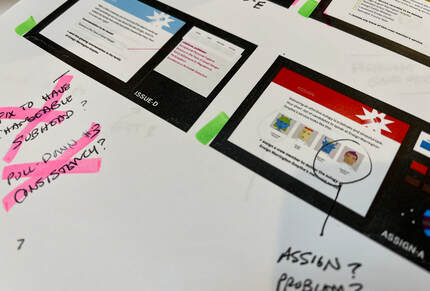

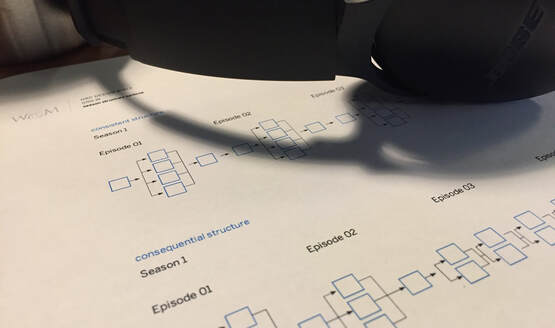
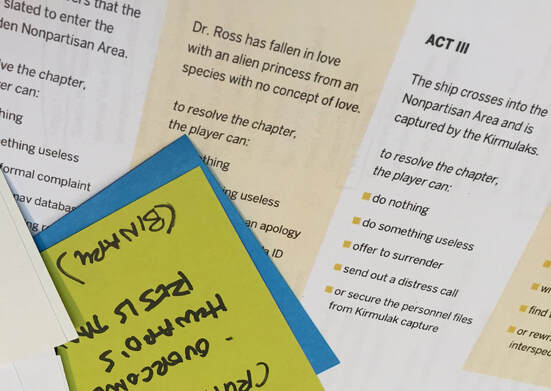
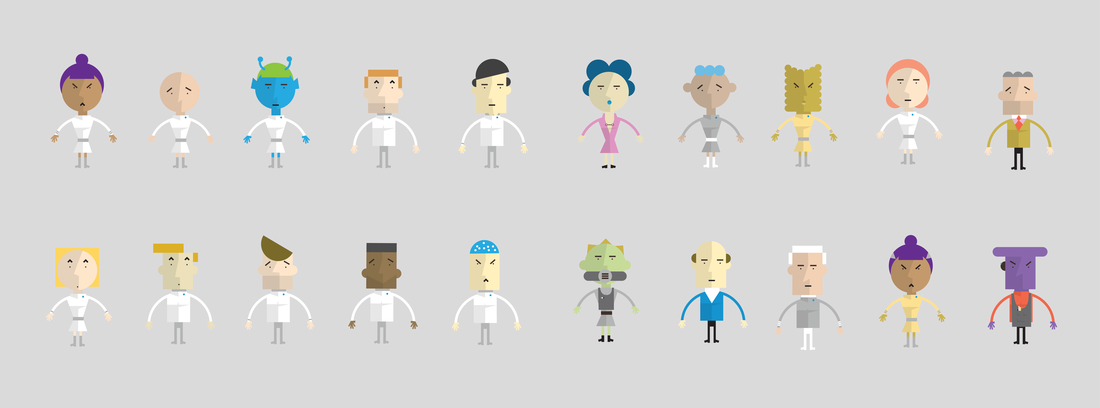

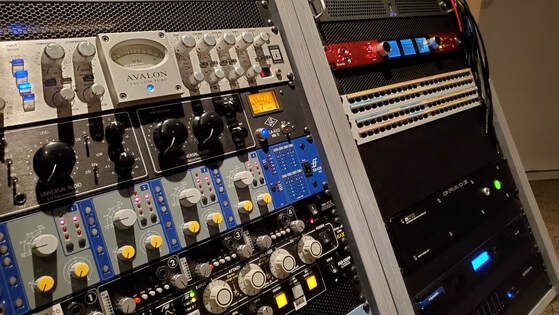
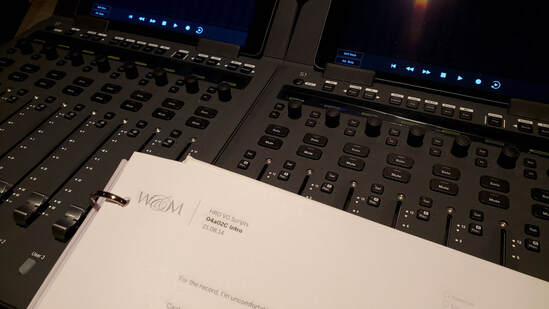
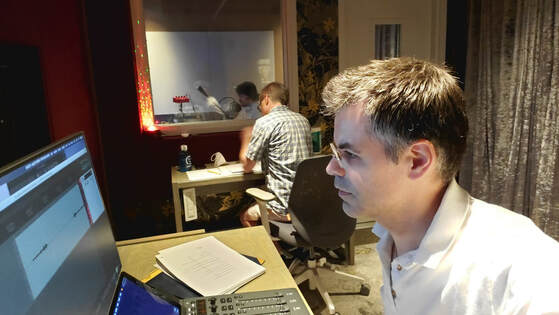


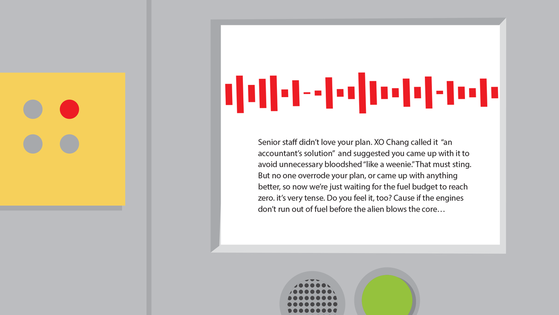
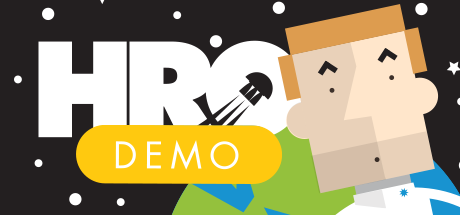
 RSS Feed
RSS Feed
